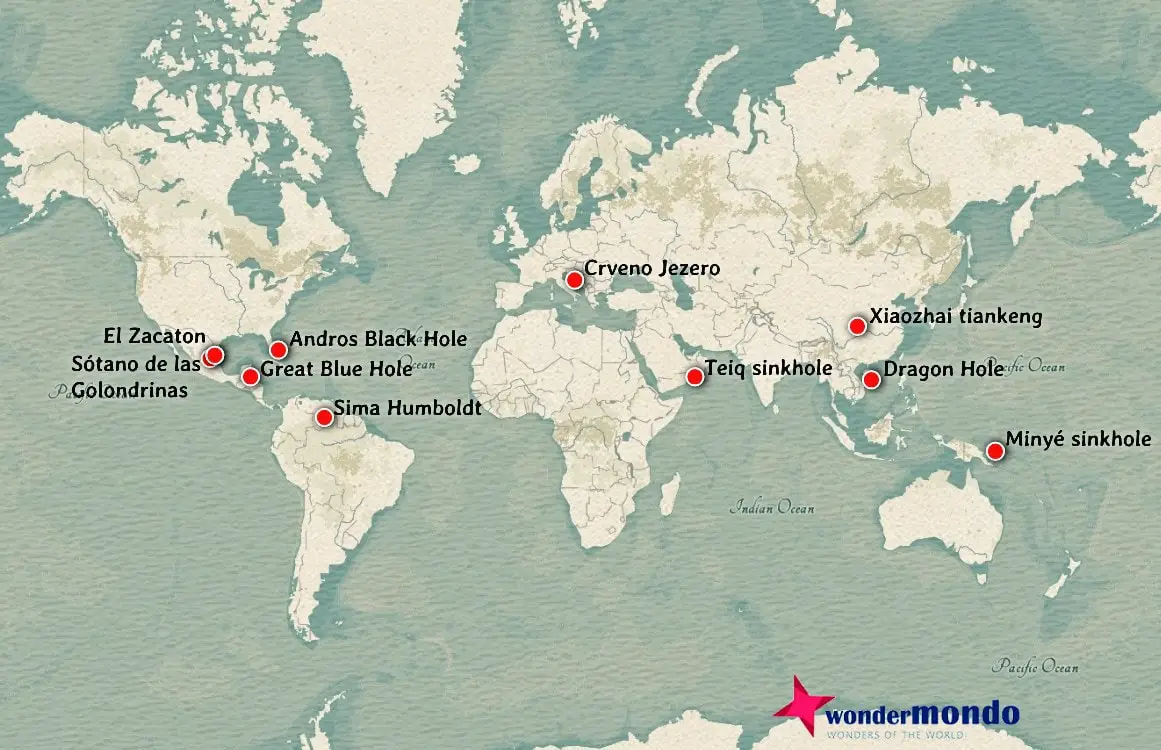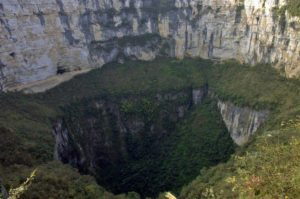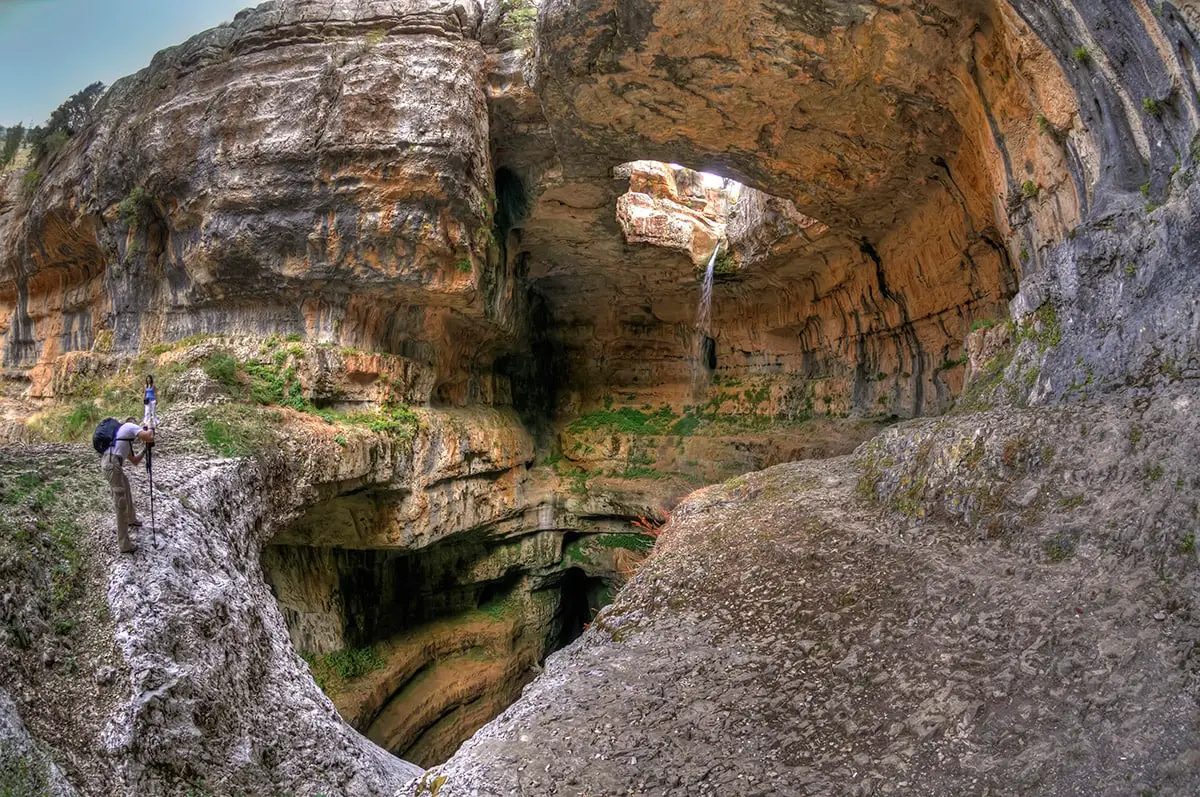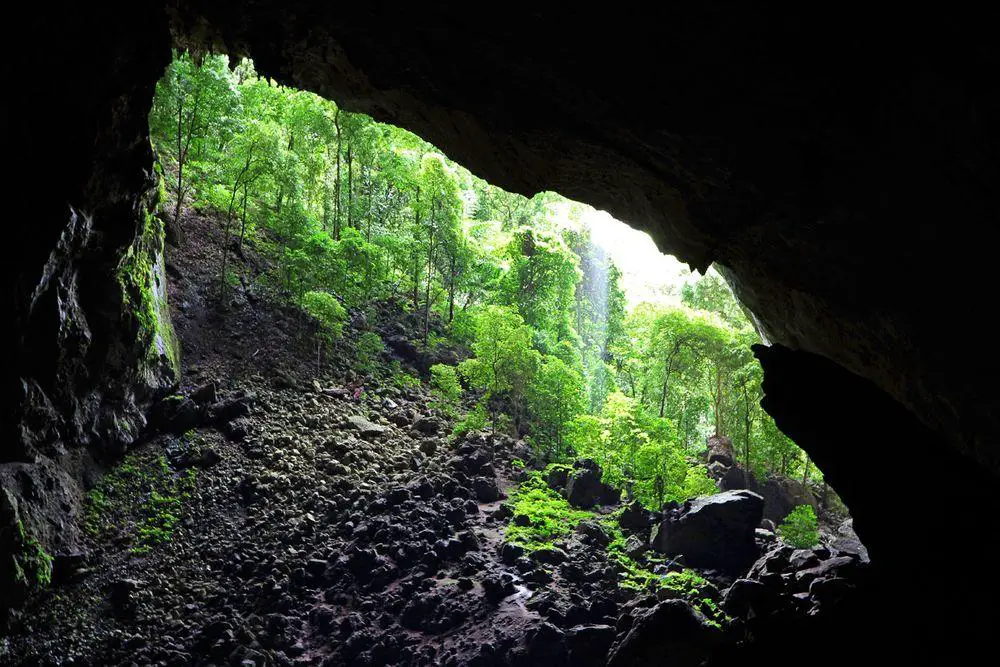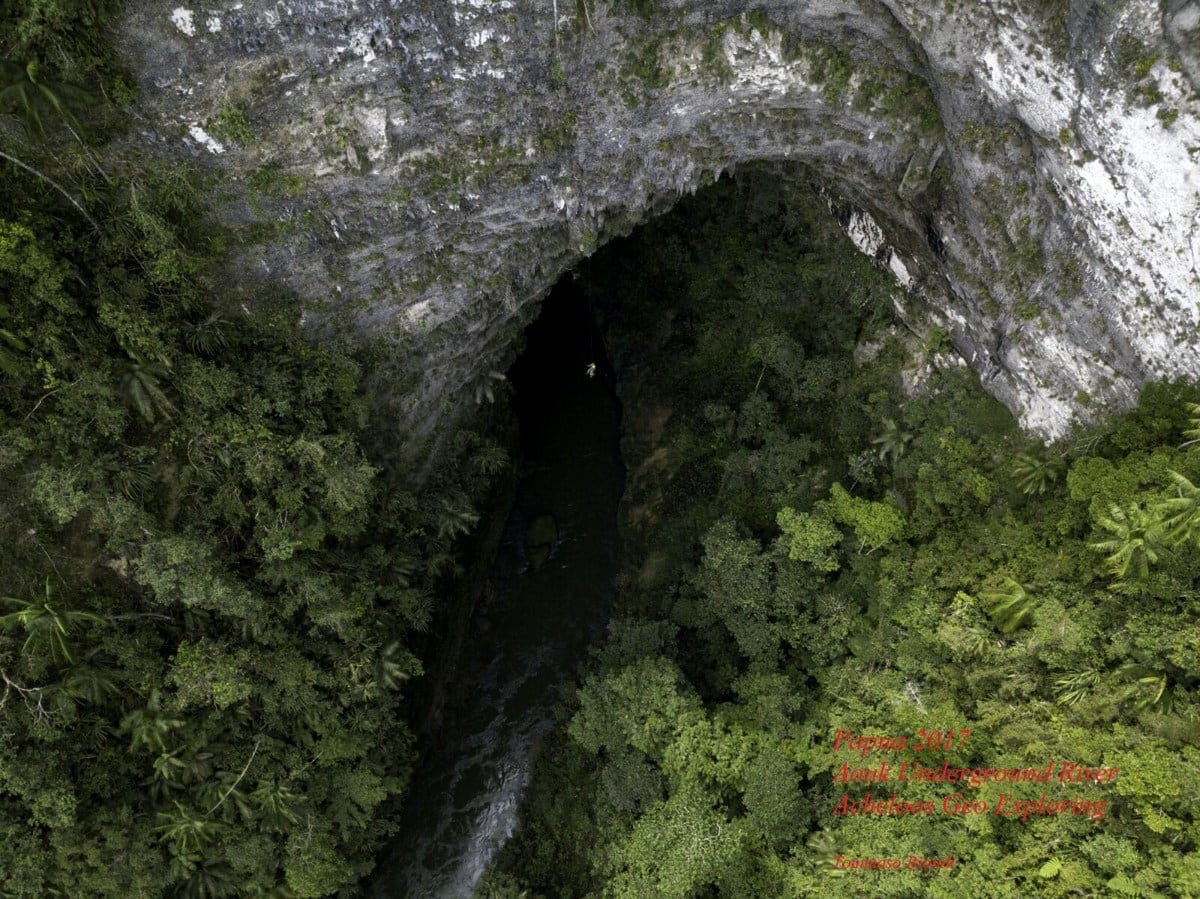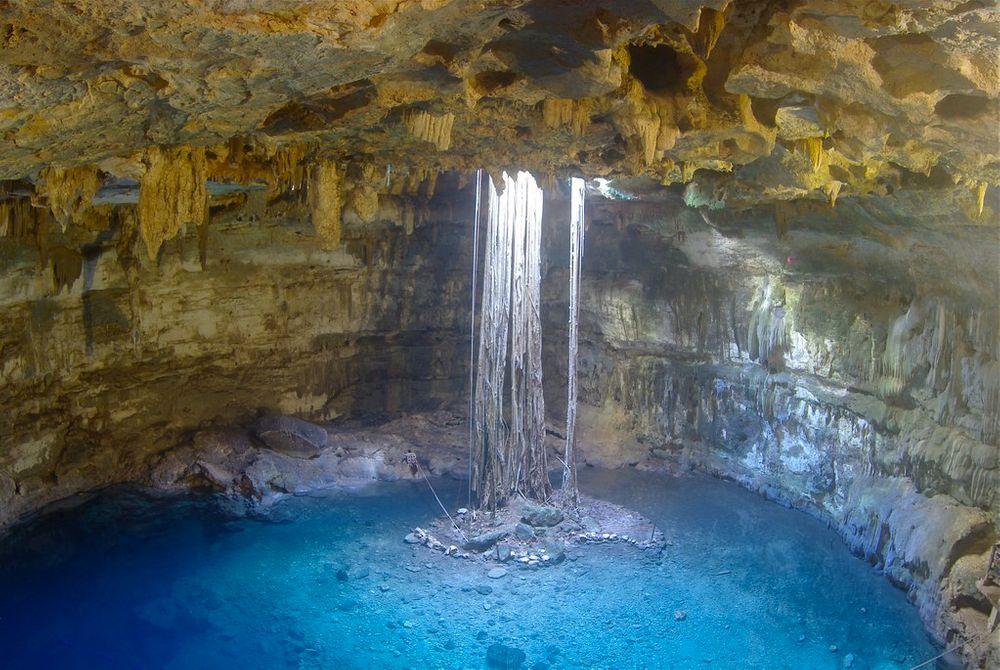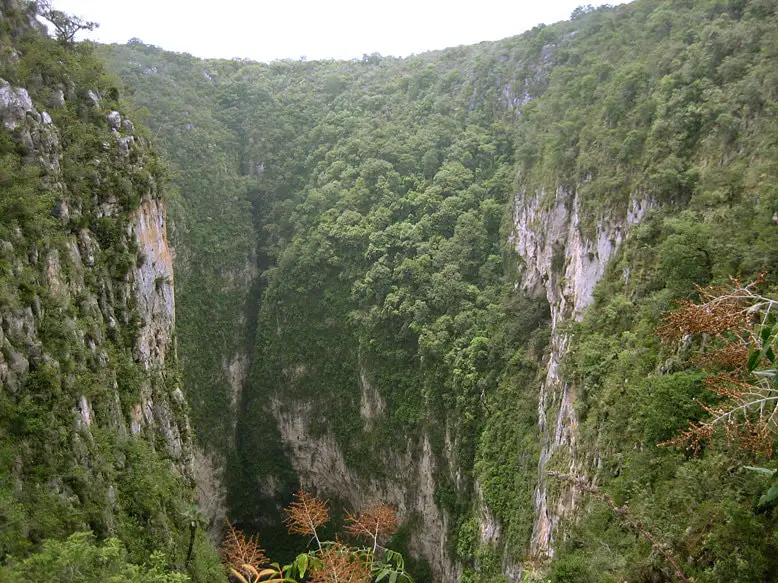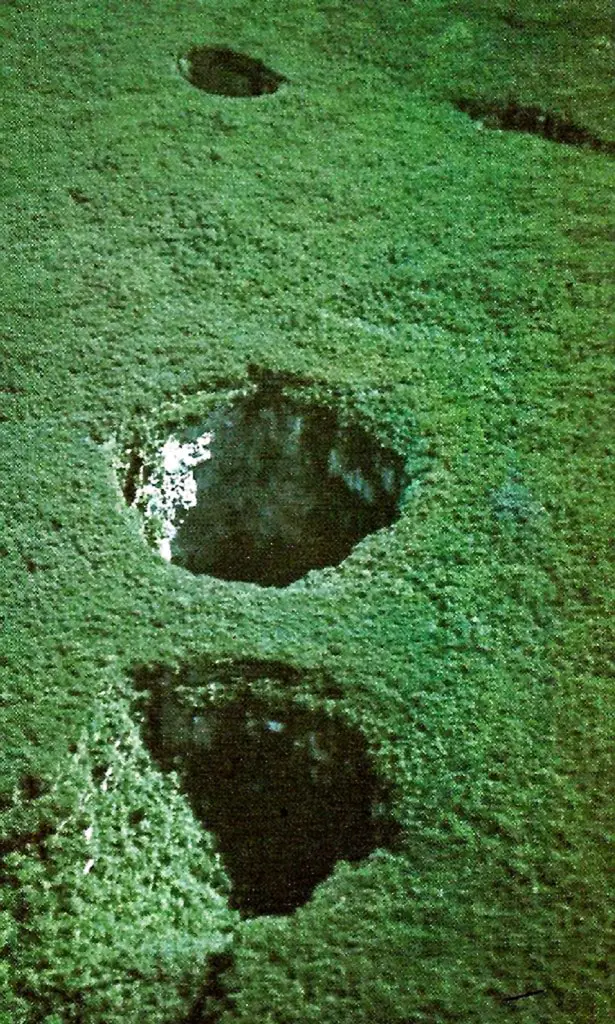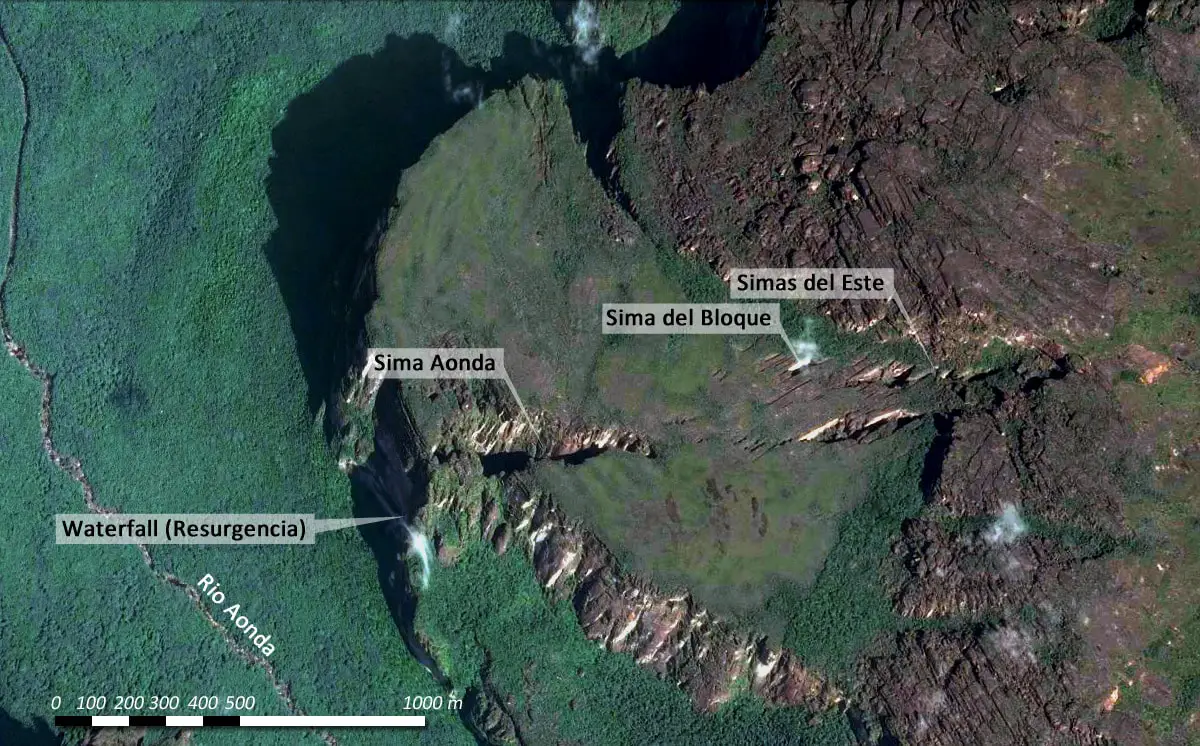Wondermondo 🢖 Categories of wonders 🢖 Geological wonders 🢖 Caves 🢖 Sinkholes
Category
Sinkholes
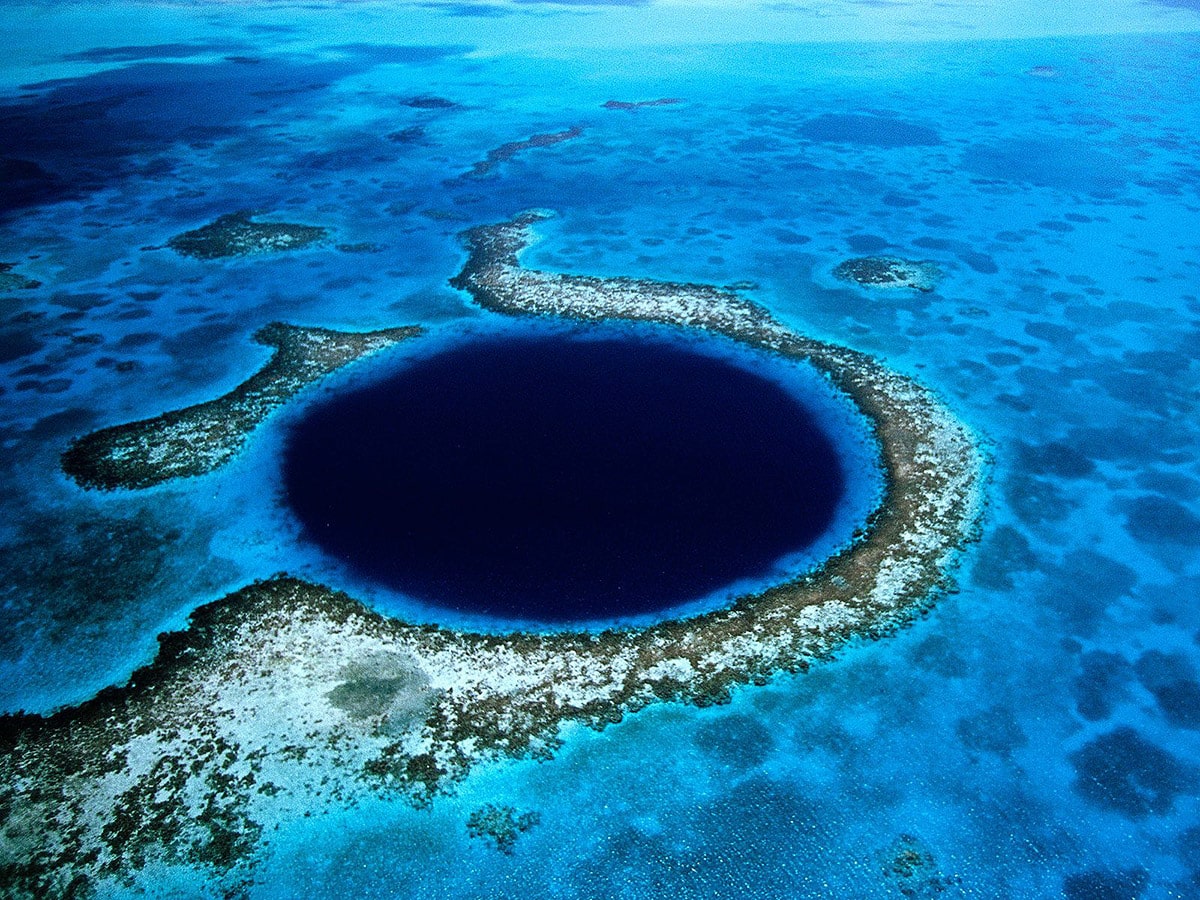
 Described sinkholes
Described sinkholes
If you see this after your page is loaded completely, leafletJS files are missing.
 What is included in this category?
What is included in this category?
This category includes outstanding sinkholes – large natural depressions or holes, which for the most part represent collapsed caves. Often there is used the equivalent term – doline – what in Southern Slavic languages means "depression". Some consider that "sinkhole" is more used in American literature and "doline" – in European, but there is not a very distinct trend.
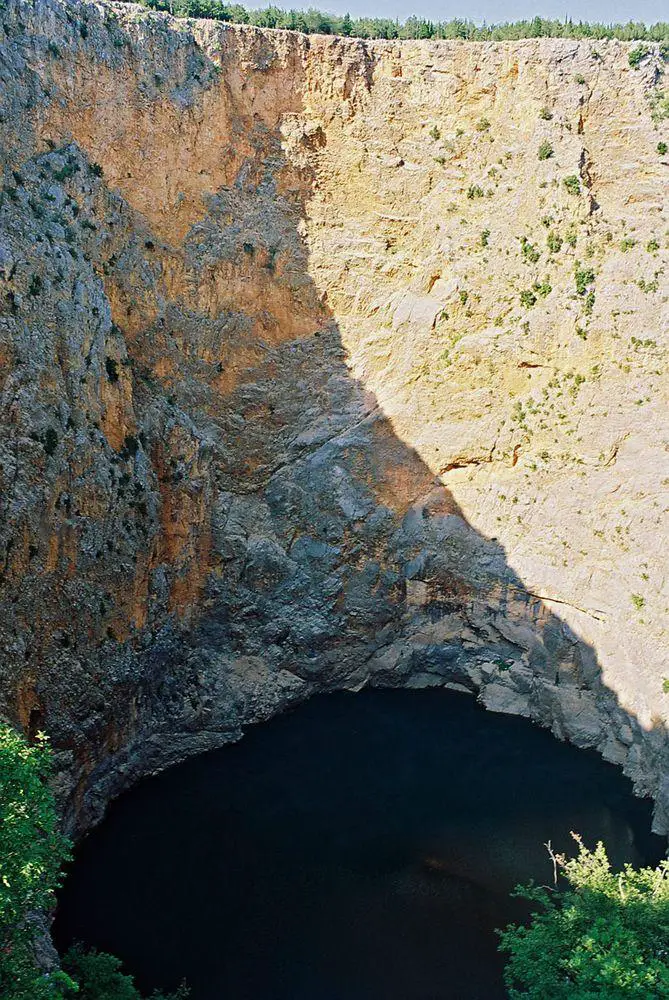
Many sinkholes, which have vertical walls, to some extent can be considered to be caves as well – although, strictly speaking, the cave is an underground void where can enter people: e.g. there is needed a layer of rock above these people. The opening of sinkholes is above the visitors.
Formation
Karst processes
Most sinkholes are formed by karst processes – by the natural solution of carbonate (f.e. limestone, dolomite), sulfide (f.e. gypsum), and salt rocks. The solution process is initiated by water.
Especially efficient is rainwater (because it is slightly acidic from atmospheric carbon dioxide) and even more – hot water (because it speeds up the solution and bears more dissolved material) and acidic water. A unique example of sinkholes created by heated, acidic water, is Sistema Zacatón in Mexico, Tamaulipas. Here have formed more than 20 karst features including more than 300 m deep sinkholes filled with warm water and some even sealed with travertine lids!
Suffosion
Few large sinkholes have formed also in a sandstone rock. Here takes place another geological process – suffosion. In many respects, it is similar to karst processes. Sand particles in sandstone are cemented – often with carbonates, clay, and sometimes also with silica. Water dissolves this cement (of course, dissolving silica is a very very slow process) and then carries away the unfettered sand particles. The largest sinkholes in sandstone are Sima Humboldt and Sima Martel in Venezuela. These are unique, up to 314 m deep holes with vertical walls and their formation has required many millions of years.
Collapse sinkholes
Most sinkholes are collapsed cave rooms (collapse sinkholes). Streams flowing through cave passages gradually increase the size of cave rooms until the roof becomes thin and collapses. If the whole layer of rock is soluble, water dissolves and brings away even the collapsed roof, and there forms a fine hole in the ground – often with the stream still flowing through it.
Erosion, vadose sinkholes
Sometimes sinkholes are formed by water entering through a vertical crevice in the rock. This crevice then gradually increases and also forms a deep hole
in the ground (erosion sinkhole, might be called also vadose sinkhole). Sometimes these sinkholes still have beautiful waterfalls falling into them. An extreme example of such sinkholes is Qingkou Tiankeng in China, Chongqing Municipality – it is 295 m deep, up to 250 m wide.
Volcanic calderas
To some extent the process of the formation of volcanic calderas is similar to the formation of traditional sinkholes. Also, volcanoes can form large underground voids which collapse, leaving enormous holes in the surface of the Earth.
The size of some volcanic calderas exceeds the size of any sinkhole. La Garita Caldera (Colorado, United States) is 35 by 75 kilometers large.
Nonetheless the mechanism of formation of volcanic calderas is driven by completely different geological processes and Wondermondo reviews them as landmarks related to volcanoes.
Changes of sea level
Karst processes mostly are ongoing above sea level – if there is a layer of carbonate rock and enough rain, caves and sinkholes and sinkholes are formed by underground streams.
In the past major areas of Earth were taken by glaciers and the sea level was lower than now. Some 20 thousand years ago the sea was even more than 100 meters below the current level.
Numerous areas around the world were dry whereas today is the sea. In some of these areas took place intense karst processes forming also deep and impressive sinkholes. Now such sinkholes are covered with seawater, forming exciting natural attractions – blue holes. Some of the most impressive are Great Blue Hole (Belize, Belize District), Dragon Hole (South China Sea, Paracel Islands) and Dean’s Blue Hole (Bahamas, Long Island).
Some types of sinkholes
Below are listed some popular kinds of sinkholes – black holes, blue holes, cenotes, sótanos, and tiankengs.
Black holes
Black holes are unique geological and biological monuments found only in Andros and Grand Bahama islands (Bahamas) – in total some 30. The best known is Black Hole of Andros (Bahamas, South Andros).
Black holes are formed in carbonate mudflats (not a common phenomenon either) – seawater slowly dissolves this clayey substance, creating amazing, round structures filled with weird, black water. These sinkholes are not too deep – up to 47 m.
The menacing black color is caused by the most amazing feature of black holes – a layer of phototrophic sulfur bacteria. This layer "swallows" the light and causes the black color of the water. Bacteria have heated up this layer up to 40°C – possibly the only case in the world where bacteria manage to heat up the water.
Blue holes
Blue hole is a term applied to some of those sinkholes which are filled with water – irrespective of their mechanism of formation. It seems that the decisive factor in the use of this term is the beautiful deep blue color of water in these formations.
This color is created by the high transparency of water and bright white carbonate sand. Blue light is the most enduring part of the spectrum: where other parts of the spectrum – red, yellow, and finally the green – are absorbed during their path through the water, blue light manages to reach the white sand and return back after the refraction.
The term has been first used in the Bahamas, where are numerous blue holes.
Cenotes
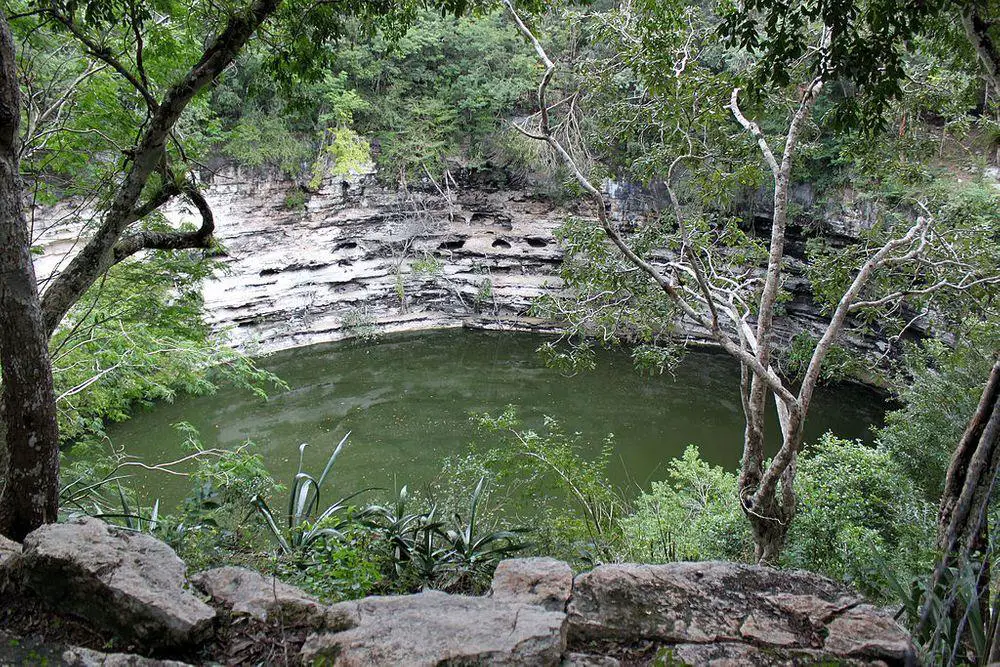
Specific monuments of nature and often – culture are many cenotes – large sinkholes found mainly in Yucatán Peninsula, Mexico. These round, water-filled sinkholes often had huge importance for nearby Mayan cities as a source of potable water and sometimes as sacrifice and ritual sites (Sacred Cenote in Yucatán, Mexico).
Formation of cenotes is linked to another unusual monument of natural history – the fall of the Chicxulub meteorite some 65 million years ago. After the fall of the meteorite formed a large basin where a thick layer of carbonate rocks was deposited. Present-day cenotes have formed along the rims of this ancient basin.
Sótanos
Some giant, deep sinkholes with nearly vertical walls in Mexico are called sótanos – the best known is the 372 m deep Sótano de las Golondrinas – Cave of the Swallows (Mexico, San Luis Potosi). several of these sinkholes correspond well to criteria of tiankengs.
Tiankengs
Extremely large and visually impressive natural sinkhole is called tiankeng – this term is introduced by Chinese geologists.
To earn this name the hole must be at least 100 meters deep and wide, with vertical walls and with a cave river below. There are some 75 tiankengs in the world, most of them in China. The largest one is Xiaozhai tiankeng (Chongqing, China): an incredible 662 meters deep and up to 537 meters wide hole with vertical walls. Another region with tiankengs is Papua New Guinea, especially New Britain island, where these sinkholes are located in the middle of lush jungle and have jungle also on their bottoms. Some more tiankengs are in Mexico, Croatia, Venezuela, and other countries.
Wondermondo’s articles about sinkholes:
 Top 25 sinkholes
Top 25 sinkholes
Africa
Dahab Blue Hole
Egypt
Approximately 130 m deep underwater sinkhole. At the depth of 56 m, there is a 26 m long tunnel – The Arch, leading out to the open sea. This unusual natural location has experienced many fatalities, bringing gruesome fame to the site.
Chinhoyi Caves
Zimbabwe
Group of legendary, sacred, and very impressive caves with up to 172 meters deep lakes (Sleeping Pool). Extremely high transparency of water where clouds and birds flying over can be seen from 30 meters depth inside the cave lake.
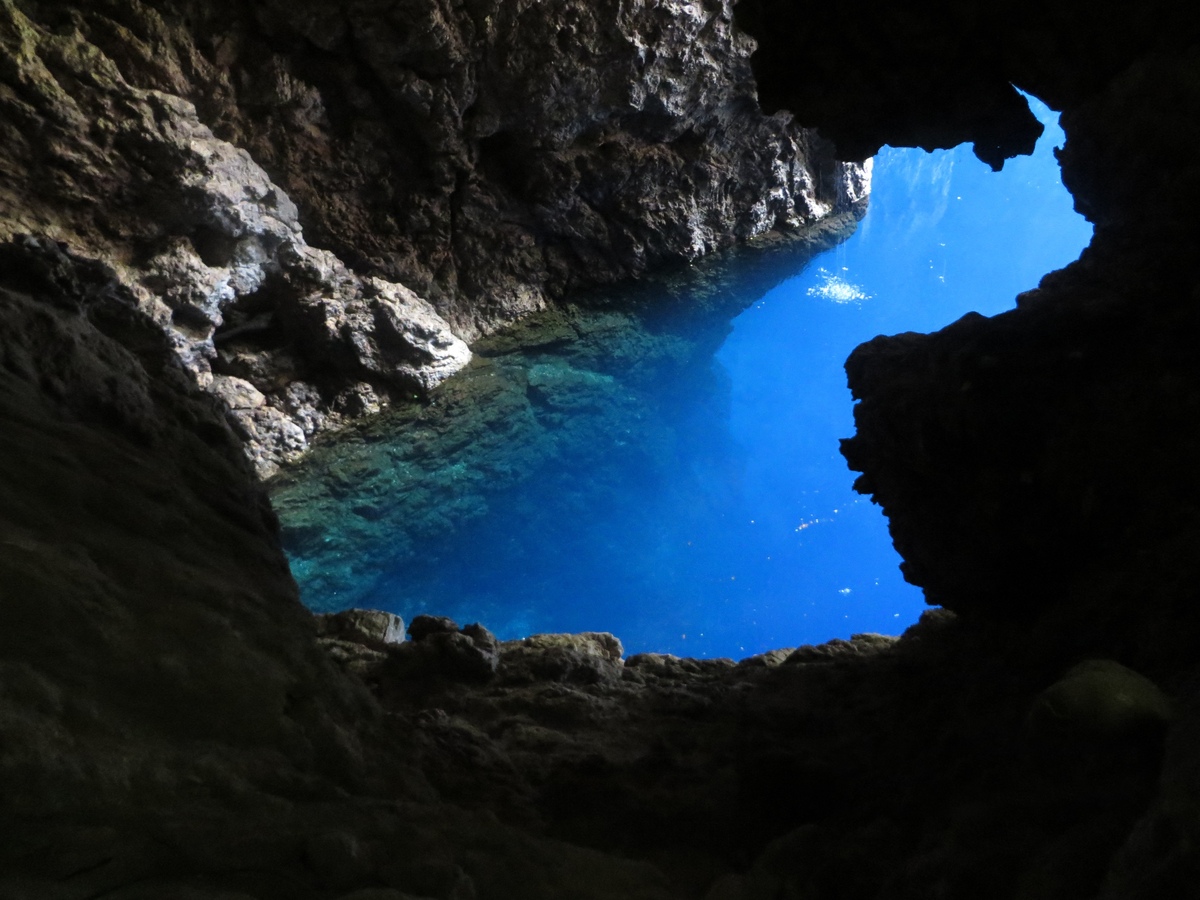
Asia
Qinlong tiankeng
China
One of the most impressive complexes of natural attractions in the world. A very impressive, enormous sinkhole, up to 276 m deep, up to 520 m wide, volume of 31.7 million m³. With the giant Qinlong natural arch, it is connected to nearby Shenying tiankeng – up to 285 m deep, and 300 m wide. Both tiankengs have two more exits through natural arches – Qinlong tiankeng can be exited through two Tianlong Natural bridges, Shenying tiankeng – through Hailong natural bridge.
Bala’a sinkhole and waterfall (Balaa)
Lebanon
Approximately 255 m deep, nearly vertical cave with waterfall in it. The entrance in the cave is a 70 m deep sinkhole. Here waterfall has percolated one side of the sinkhole, creating three natural bridges one above the other. Waterfall disappears underground.
Xiaozhai tiankeng
China
Largest sinkhole (tiankeng) in the world, up to 662 meters deep, 625×535 meters across.
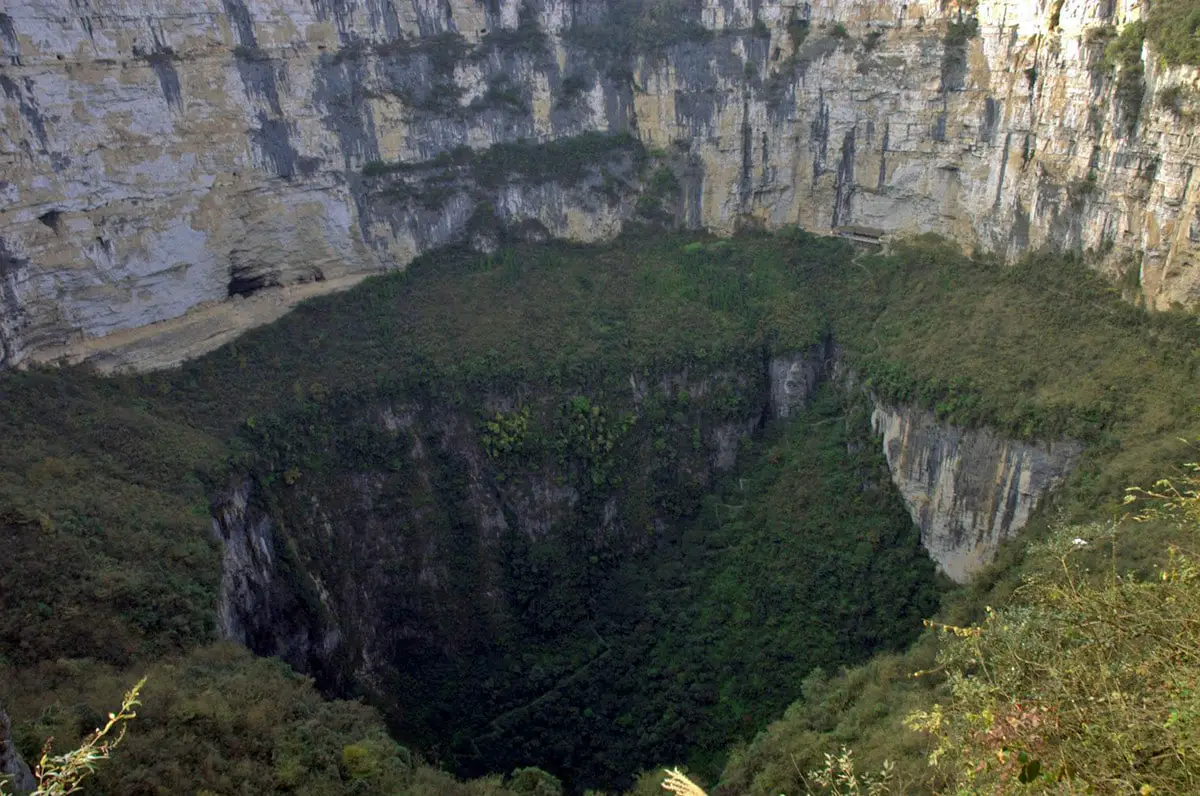
Dashiwei tiankeng
China
One of the largest sinkholes in the world – up to 613 meters deep, 600×420 m across.
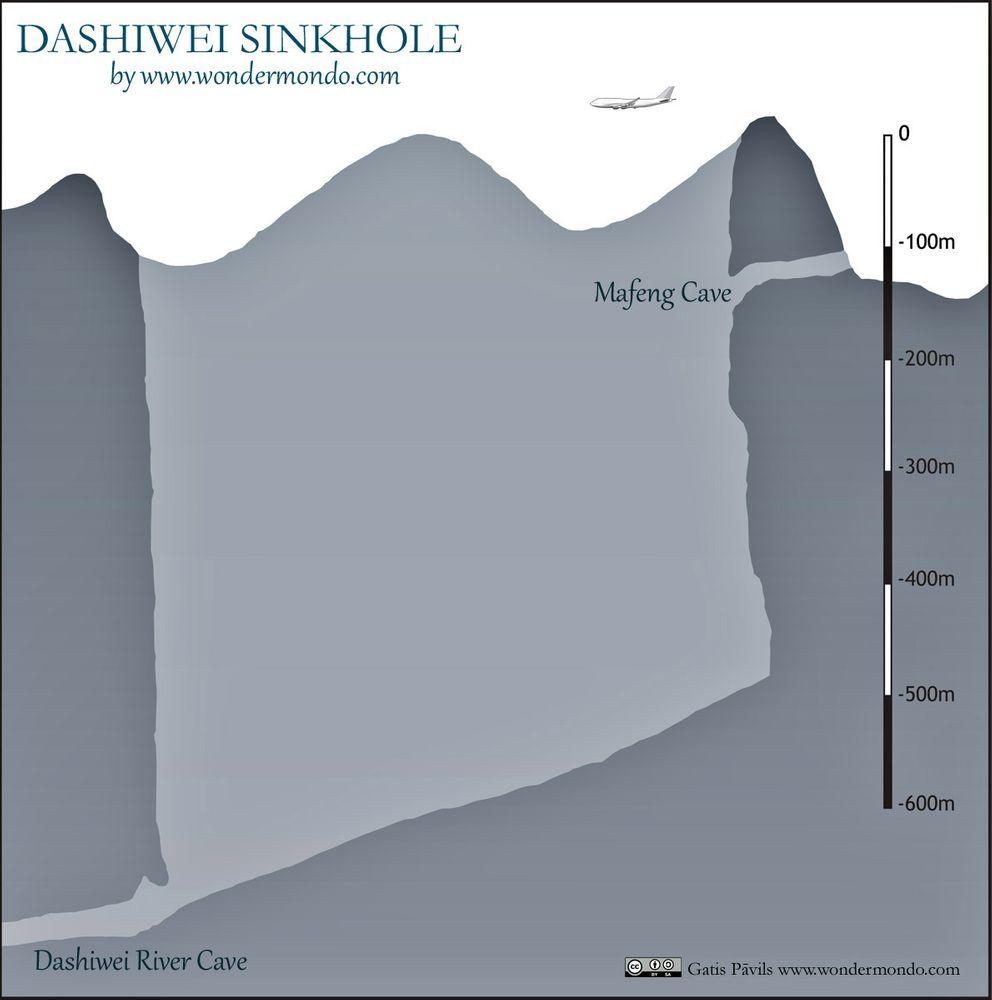
Garden of Eden on Sarawak
Malaysia
Possibly the world’s largest sinkhole that from three sides is surrounded by 150 – 300 m high vertical walls. This is a former giant cave chamber with two giant caves (Deer Cave and Green Cave) continuing on both sides of the Garden of Eden. Volume – 150 million m³, size 1,200 x 1,000 m.
Aouk-Kladuk Underground River
Indonesia
World’s most powerful underground river. Aouk-Kladuk Underground River is some 1.5 kilometers long. The stream has a volume of 130 – 180 cubic meters.
Majlis al Jinn (Khoshilat Maqandeli)
Oman
Ninth largest cave chamber in the world in a unique setting, available only by abseiling 118 – 158 meters from the ceiling through a comparatively small hole. People live on the top of this enormous chamber that has only 40 meters thick ceiling. The cave contains one of the largest cave chambers in the world – 340 m long and 228 m wide, 150 m tall, floor area is 58,000 m².
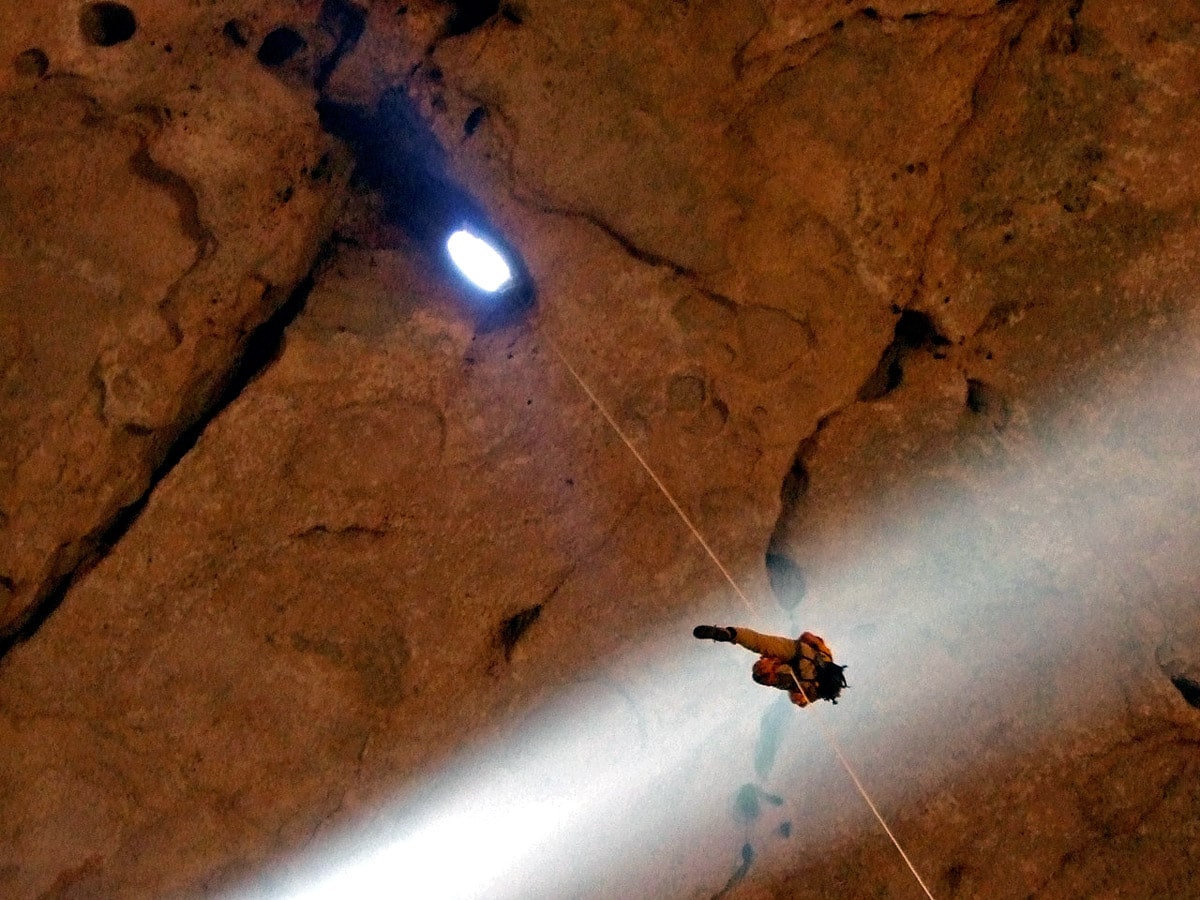
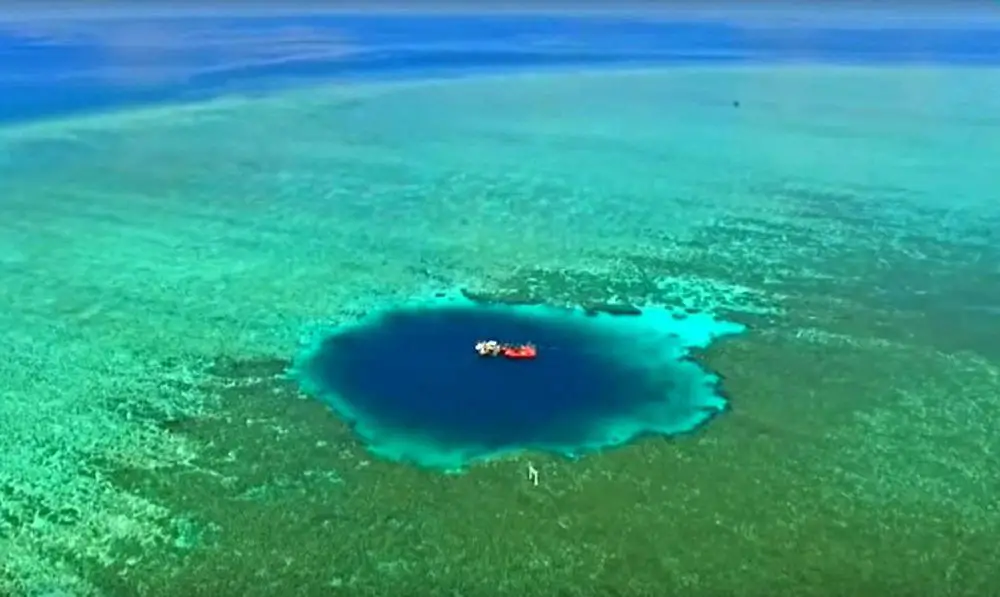
Australia and Oceania
Minyé sinkhole and cave
Papua New Guinea
One of the largest and most impressive tiankengs (giant sinkholes) in the world, located in an exotic jungle and crossed by a powerful underground river. Up to 510 meters deep, 350 meters across, volume – 26 million m³. It continues as a cave system. The explored length of cave passages is 5,421 m, maximum depth – 468 m. Contains one of the largest cave rooms in the world – the Tuké room, 240 m long, 200 m wide, and 130 m high.
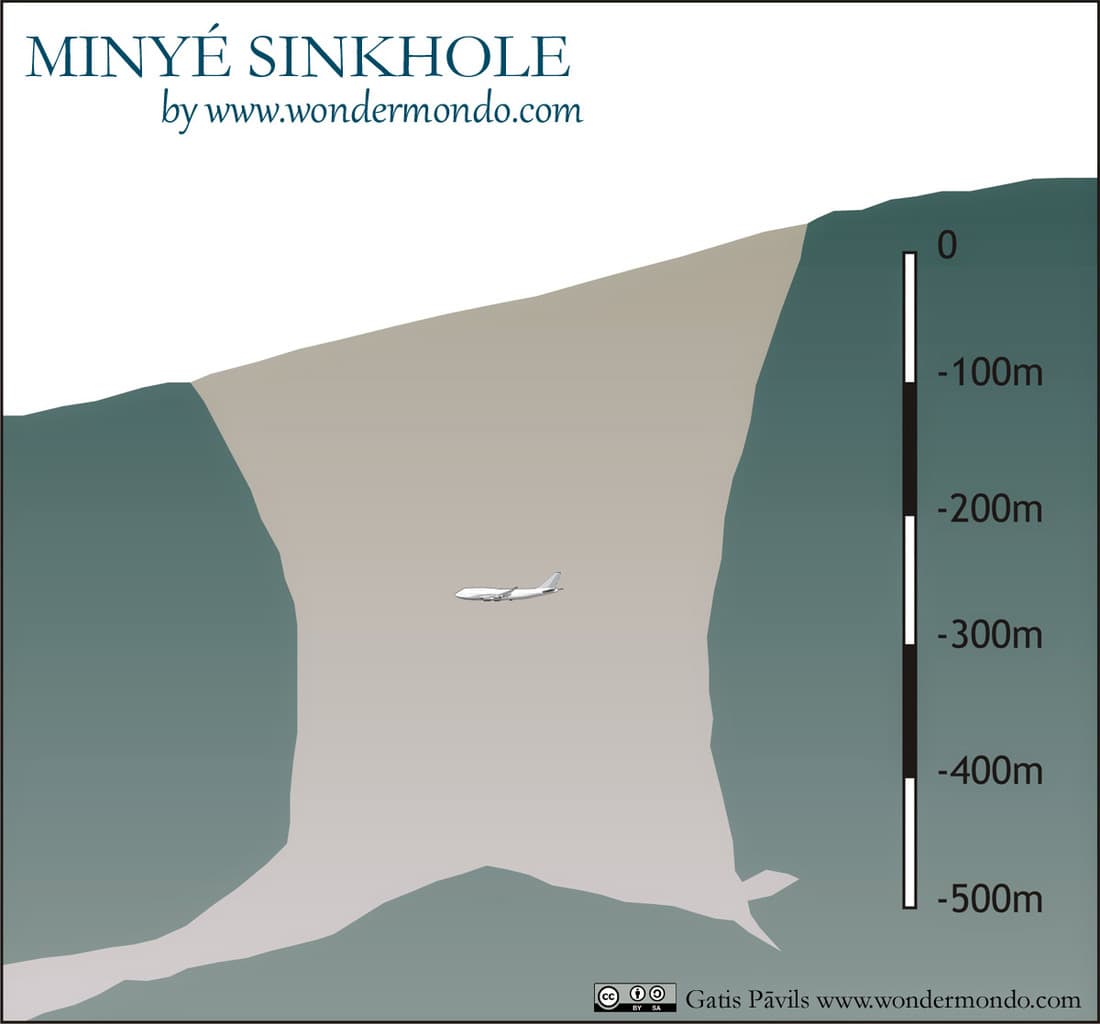
Naré sinkhole
Papua New Guinea
One of the most spectacular sinkholes in the world, also located in an exotic jungle. Up to 310 meters deep, up to 150 meters across, volume – 4.7 million m³. Walls are overhanging and below flows a powerful river. At the top part of the sinkhole, inside it often is seen clouds. The further cave reaches 415 m depth.
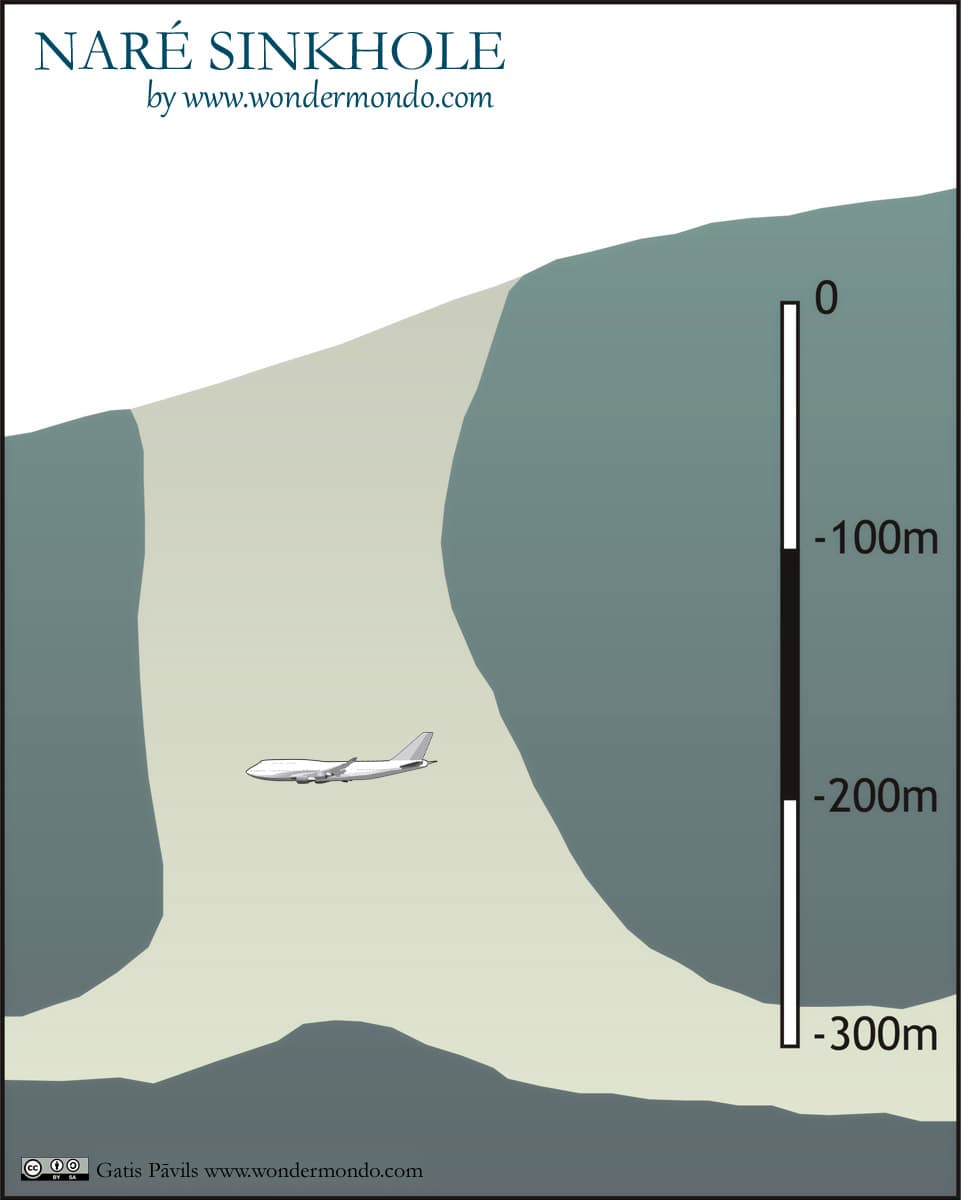
Europe
Crveno Jezero (Red Lake)
Croatia
One of the most impressive sinkholes in the world: a deep shaft with a lake at the bottom. The total depth of the sinkhole is some 530 m, it contains a 280 – 290 m deep lake with endemic fish.
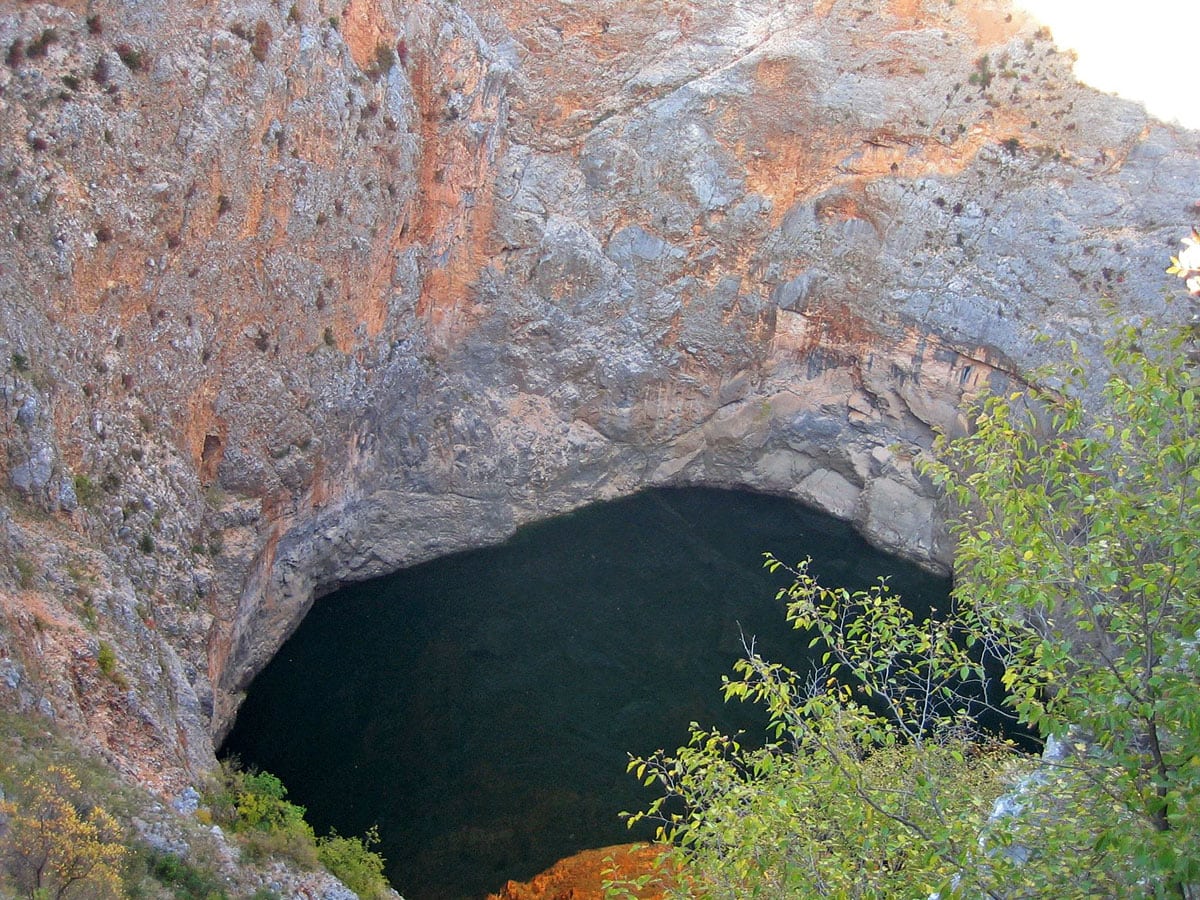
North America
Great Blue Hole
Belize
A perfectly round undersea sinkhole, 318 meters across and 124 meters deep. Contains tilted stalactites possibly hinting at tectonic movements.

Sistema Zacaton
Mexico
Unique karst field created by thermal acidic waters heated by volcanic heat. Contains the world’s deepest water-filled sinkhole, the 339 meters deep El Zacatón sinkhole with 319 meters deep lake, and floating islands. Poza Seca is one of the unique travertine-capped sinkholes of Sistema Zacatón – here the formerly open sinkhole has sealed itself with a limestone lid. Most likely it hides unknown life forms, not investigated.
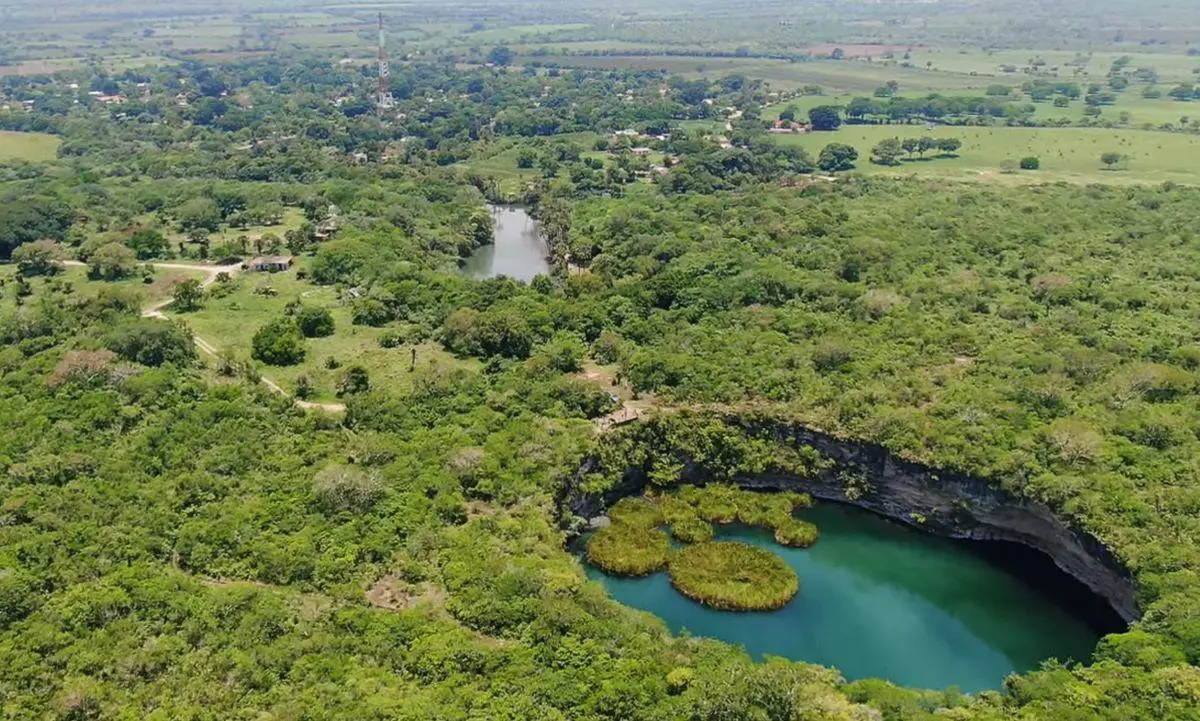
Sótano de las Golondrinas (Cave of Swallows)
Mexico
The largest cave shaft in the world – an enormous 49 x 62 meters wide hole, 372 meters deep. Famous due to a group of green parrots who have to fly ascending in circles around the cave until they get out of it.
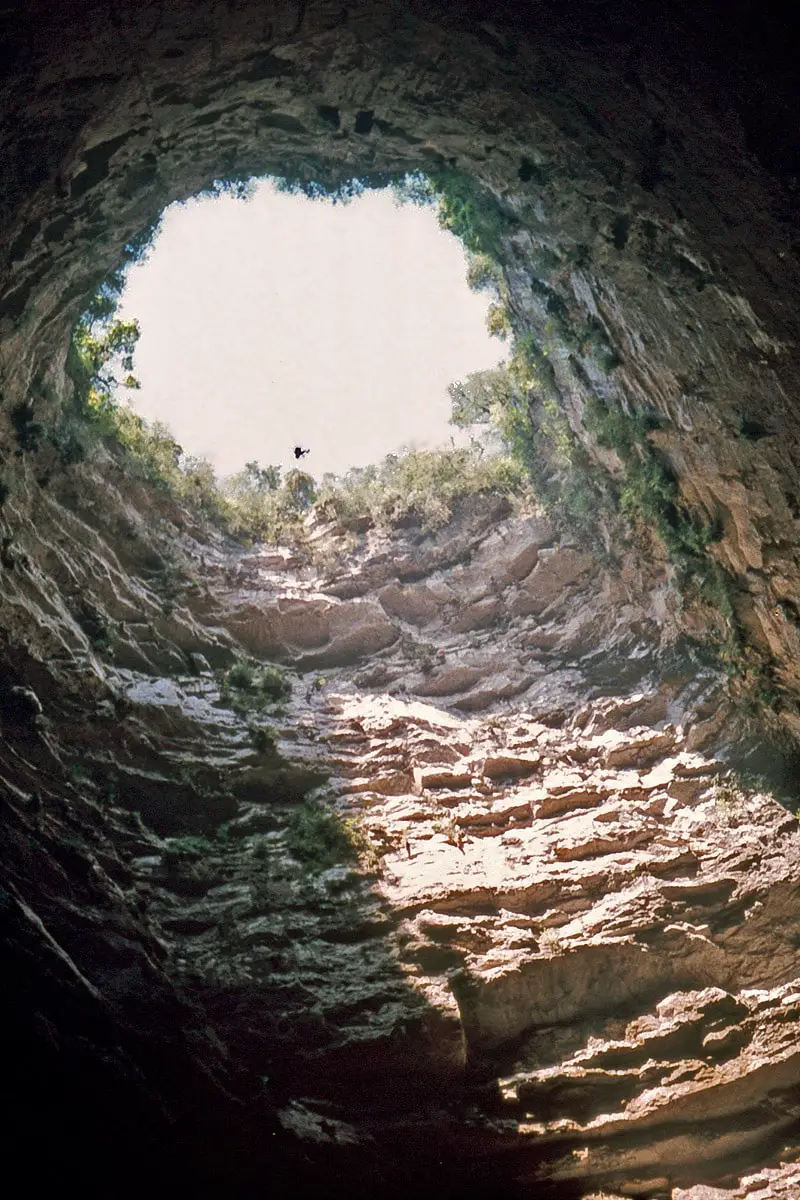
El Zacaton sinkhole
Mexico
The second deepest water-filled sinkhole in the world. The total depth of the sinkhole is 339 m, and the lake is 319 m deep. On the surface of the lake, there are floating several round travertine islands. Lake is formed by volcanically heated acidic groundwater.
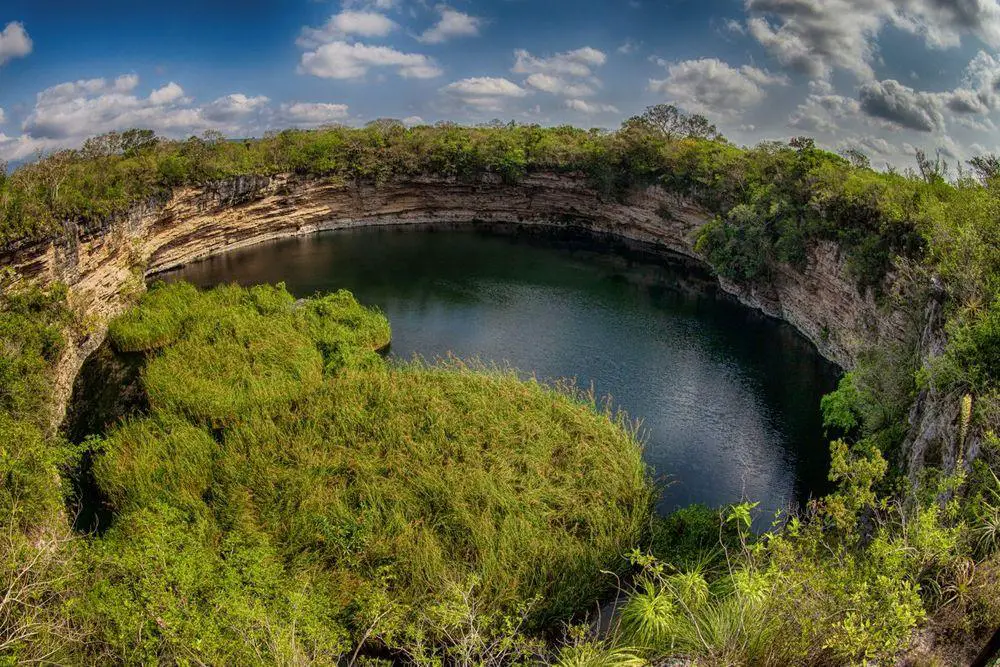
Cenote Angelita
Mexico
Unique water-filled sinkhole with a ghostly layer of hydrogen sulfate at the depth of some 30 m and seawater below it.
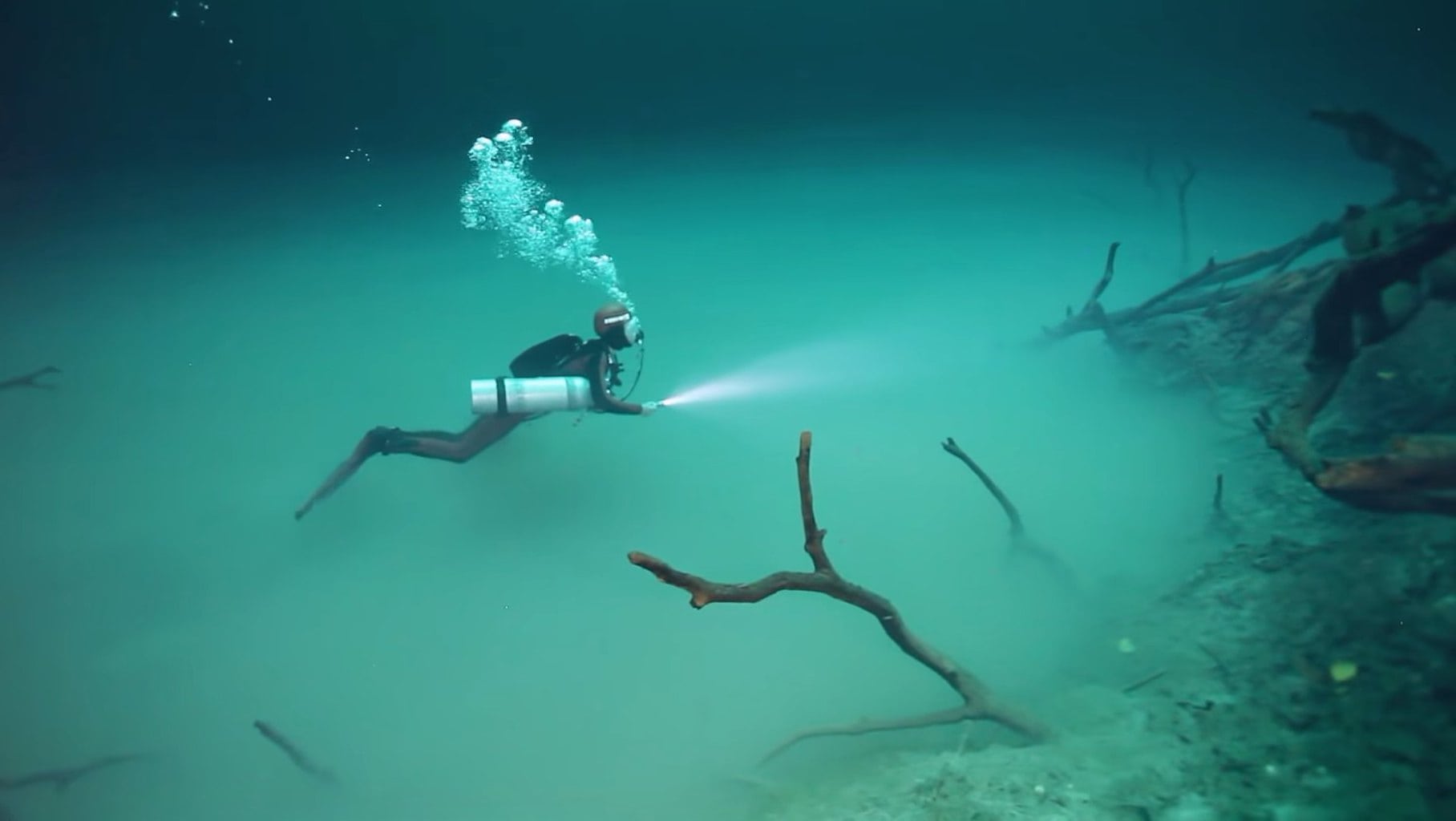
Black Hole of Andros
Bahamas
300 m wide and up to 47 m deep round water-filled sinkhole with a layer of violet jelly layer of bacteria at 18 meters depth. Microorganisms have heated up the water to 40°C.
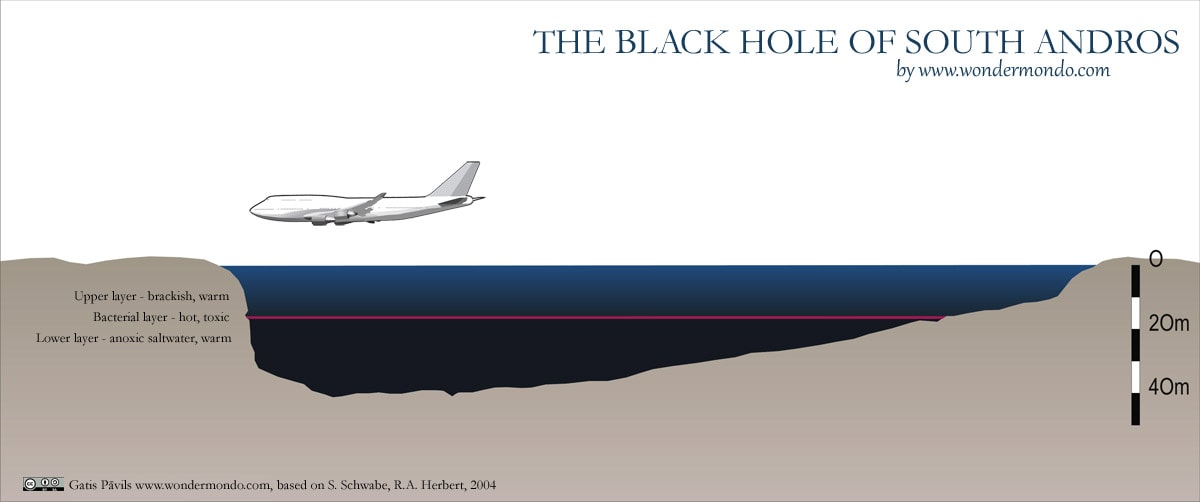

Hoya de las Guaguas
Mexico
Sinkhole – a cave of giant size. The entrance shaft is 202 m deep, a total depth of 478 m, cave chamber up to 290 m tall. Thousands of swifts and parrots live in the sinkhole.
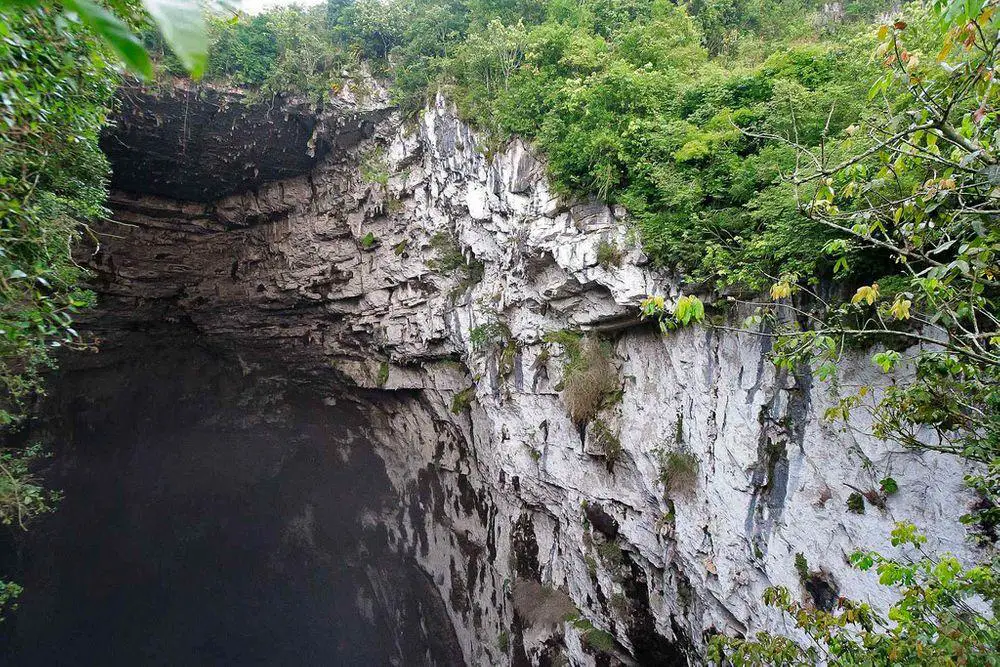
X’kekén Cenote (Dzitnup Cenote)
Mexico
One of the most photographed cenotes, with a beautiful deep blue lake and sunbeam lighting it through the ceiling, numerous stalactites. At least 35 m across, the distance between the ceiling and water is some 20 m.
Sótano del Barro
Mexico
One of the largest sinkholes in the world, 455 m deep, with 410 m direct fall. Width – 420 m, formed in Lower Cretaceous limestone.
South America
Sima Humboldt and Sima Martel
Venezuela
314 and 248 meters deep, ancient quartzite sinkholes on the top of forested table-top mountains and containing patches of isolated, primeval rainforest on their bottoms.
Sima Aonda
Venezuela
383 meters deep, ancient quartzite sinkhole. The stream that flows through it, emerges at one side of the steep wall of Auyantepui, and here, in the open air, it falls down for some 100 m.
 Recommended books
Recommended books
Sinkholes and Subsidenced
“Sinkholes and Subsidence” provides a twenty-first century account of how the various subsidence features in carbonate and evaporite rocks cause problems in development and construction in our living environment. The authors explain the processes by which different types of sinkholes develop and mature in karst terrains.
Karst Hydrogeology and Geomorphology
Originally published in 1989, Karst Geomorphology and Hydrology became the leading textbook on karst studies. This new textbook has been substantially revised and updated.

